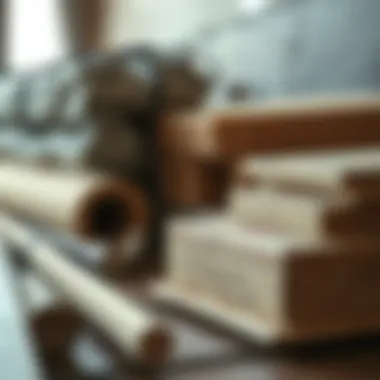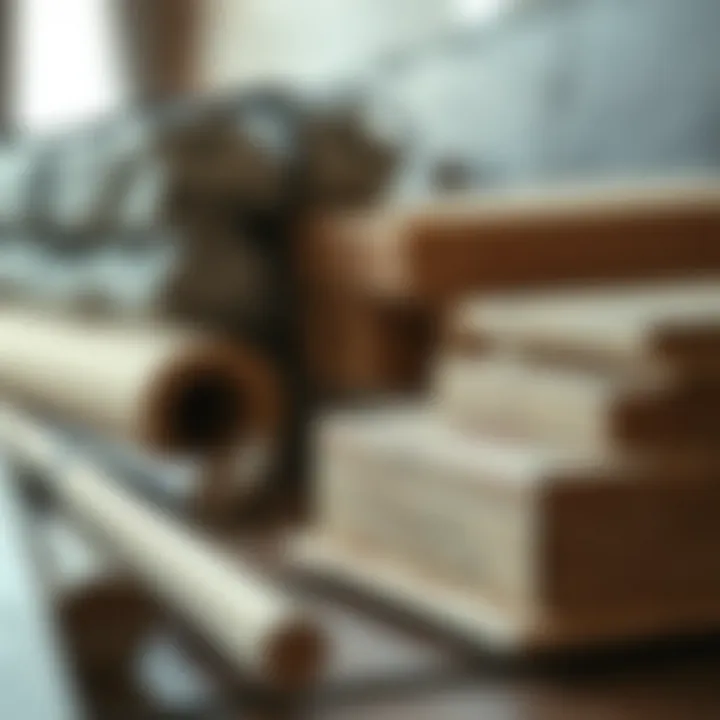Comprehensive Guide to House Rehabilitation Costs


Intro
Rehabilitating a house can often feel like walking a tightrope between opportunity and risk. Whether you’re a greenhorn dabbling in real estate or a seasoned investor scouting for your next project, understanding the costs involved is crucial. This endeavor is not just about hammering nails and slapping on some paint; it extends far deeper into budget forecasting, labor negotiations, and material sourcing. In the sections that follow, we will unpack the various dimensions of these costs, offering a roadmap that steers you clear of common pitfalls.
Equipped with this knowledge, you’ll find yourself better positioned to navigate what can often be a financially treacherous journey. From labor wages varying by region to material price fluctuations due to market trends, each choice you make could profoundly affect your bottom line.
Let’s delve into the heart of the matter by first clarifying some essential financial definitions that will guide our discussion.
Key Definitions
Understanding a few key terms will significantly aid your comprehension of the rehabilitation process. These terms often pop up in conversations about investment and budgeting, so let’s break them down.
Essential Financial Terms
- Capital Expenditure (CapEx): This refers to the funds used by a company, or an investor, to acquire or upgrade physical assets. In terms of house rehabilitation, it often covers renovations and improvements that enhance property value.
- Operating Expenses (OpEx): Unlike CapEx, these are the regular expenses required for maintaining the property. This can include utilities, maintenance fees, and insurance.
- Return on Investment (ROI): ROI is a measure used to evaluate the efficiency of an investment, calculated by dividing the net profit from the investment by the initial capital cost. It’s essential for gauging the potential profitability of rehab projects.
- Contingency Fund: A safety net that accounts for unexpected costs. Generally, it’s good practice to reserve 10-20% of your total budget for such surprises.
Terminology Breakdown
Understanding the nuances of these terms will not just help you during the planning stages; knowing them will empower you in negotiations with contractors and suppliers, ensuring you’re not left out to dry. With these definitions under your belt, you can approach budgeting with greater clarity, guiding both your short-term spending and long-term investment strategies.
"Proper planning is not just a guide; it's your shield against the unforeseen."
Now that we’ve weathered the storm of definitions, let’s shift our focus to expert insights that can illuminate the path ahead.
Expert Insights
When it comes to house rehabilitation, insights from those who've walked the walk can save you a boatload of time and money. Let’s explore some investment strategies and analyze current market trends.
Prelude to House Rehabilitation
House rehabilitation is a topic that often gets glossed over in mere conversations about property investments. However, understanding its nuances could very well shape the future of your real estate endeavors. Whether you're a novice eager to try your hand at investment or a seasoned investor looking to maximize returns, grasping the intricacies of house rehabilitation becomes essential. This article seeks to peel back the layers on various cost factors involved, outlining the path from initial costs through to project completion.
Defining House Rehabilitation
At its core, house rehabilitation refers to the process of restoring, updating, or modifying a property so that it meets current standards and expectations. This might include everything from structural repairs, plumbing upgrades, to aesthetic changes like new paint or flooring. But it isn't a one-size-fits-all concept. There are different levels of rehabilitation, which can range from minor renovations to major overhauls. For instance, some investors might only need to paint the walls or replace the carpet, while others might be looking to replace outdated plumbing or electrical systems. Each of these options comes with varying cost implications and potential return on investment.
The Importance of Rehabilitation
Why bother with rehabilitation? Well, when executed properly, it can yield a significant increase in property value. Think of it as a kind of facelift for a home. A tired property can be transformed into a cozy, appealing living space that draws in potential buyers or renters. Furthermore, rehabilitating properties helps in revitalizing neighborhoods, attracting new occupants, and sometimes driving up property values in the area overall.
When you look at the statistics, a well-executed rehabilitation project can lead to returns ranging anywhere from 10% to 30% or more, depending on the original purchase price and the extent of the work completed.
Initial Cost Assessment
Evaluating the initial costs when considering house rehabilitation is a pivotal step in the journey of transforming an old property into a dream home or a lucrative investment. This phase lays the groundwork for what’s ahead and impacts not just budgetary concerns but also the overall direction of the project. If you rush into this aspect without thorough consideration, you might find yourself neck-deep in expenses that could have been anticipated and mitigated.
Evaluating Property Condition
The first order of business in this assessment is to evaluate the condition of the property. This is akin to checking the engine of a car before a long road trip; you wouldn’t start the journey without knowing whether the vehicle is good to go. Here are key elements to consider:
- Structural Integrity: Start by looking at the foundation, walls, and roof. Are there cracks, mold, or signs of water damage? These could signal larger issues that require significant funds to address.
- Electrical and Plumbing: Inspect the electrical panels, wiring, and plumbing fixtures. Outdated systems could be a disaster waiting to happen and might require a complete overhaul.
- Interior and Exterior Condition: Look closely at the flooring, windows, doors, and even the yard. When these features are in disrepair, it can drive up costs unexpectedly.
A comprehensive inspection comprised of specialist assessments helps in pinpointing what needs immediate attention. Hiring professionals might seem like another cost to bear, but in the long run, it saves funds by preventing costly mistakes that could emerge later.
Setting a Budget
Once the property is assessed, setting a budget becomes the next Herculean task. Think of this phase as drawing a road map for your journey; without it, you might take many wrong turns and end up off the beaten path. Here are some considerations to keep in mind:
- Itemizing Costs: Break down the costs into specific categories. Include major components such as demolition, repairs, materials, and labor. Understanding each segment's cost gives a clearer picture of total expenses.
- Contingency Budget: It’s wise to have a cushion for unexpected costs, typically as much as 10-20% of the total budget. This safeguard helps to accommodate surprises that often crop up in renovation projects.
- Financing Options: Think about how you’ll cover these costs. Will you be cashing out your savings, or are you looking at loans? Each option carries its implications, which influences the overall project cost.
Engaging in transparent discussions with contractors and suppliers during this process ensures everyone is singing from the same hymn sheet regarding costs.
"An ounce of prevention is worth a pound of cure." - This adage rings particularly true in setting the correct budget and evaluating the property’s state. Taking the time to plan out these costs diligently pays off handsomely in the end.
Labor Costs in Rehabilitation
When talking about the process of house rehabilitation, labor costs usually stand as a significant chunk of the overall budget. These expenses are often underappreciated or miscalculated, leading to unpleasant surprises down the road. Understanding where the money goes when it comes to hiring workers is essential for anyone embarking on a rehab project, whether it’s a first-time venture or part of a seasoned investor's portfolio.
Skilled Labor versus Unskilled Labor
The distinction between skilled and unskilled labor is pivotal in determining your project’s cost. Skilled labor refers to individuals who have specialized training or education in areas such as electrical work, plumbing, or carpentry. These professionals carry certifications and possess years of experience, making them more reliable for complex tasks. On the other hand, unskilled labor comprises workers who might not have any formal training; examples include laborers performing simple tasks like demolition or painting.
Investing in skilled labor can often save money in the long run. Poor workmanship can lead to costly mistakes, potentially requiring additional funds to rectify issues that come to light later. Unskilled labor might lure you in with lower hourly wages, but if the job isn’t done right the first time, it could lead to frustrating and expensive fixes.
Key Considerations:
- Expert Skills: Skilled workers are crucial for tasks requiring precision while affecting safety and functionality.
- Quality vs. Cost: It may be tempting to save on labor, but a cheaper rate often leads to compromised quality.
- Longevity: The work completed by skilled labor can endure better over time, leading to fewer repairs down the road.
Understanding Labor Rates
Labor rates vary widely depending on factors such as the region, the complexity of the job, and the prevailing economic conditions. Typically, urban areas enjoy a higher cost of labor given their increased demand for skilled workers, whereas rural settings might present somewhat lower costs.
Moreover, labor rates may fluctuate based on the season. For instance, summer often sees a spike in construction jobs as many homeowners plan renovations during warmer months. This heightened demand could push wages upward.
Here are some typical considerations to keep in mind:
- Hourly vs. Project-Based Costs: Some contractors operate on hourly rates, while others may quote a project fee. Understanding these systems can help you better plan your budget.
- Negotiation: Don’t shy away from negotiating labor rates or seeking multiple quotes; it might just save you a pretty penny.
- Hidden Costs: Some labor costs go beyond wages alone. Additional charges might include benefits, insurance, and equipment rentals, which need to be accounted for in your budget.
"The labor cost might seem like just a line item until you're knee-deep in the project and realize the impact of every expertise needed."
Material Costs and Sourcing
Understanding the significance of material costs and sourcing is crucial for anyone embarking on a house rehabilitation journey. The materials you choose not only influence the final aesthetic of your project but also dictate the total expense. Those who underestimate these costs may find themselves in a financial pickle, generating budget overruns. It's wise to remember that quality materials can yield durability and reduce maintenance down the line.
Moreover, reliable sourcing can lead to better pricing and potentially long-term relationships with vendors who understand your needs. Essentially, the careful selection of materials and suppliers can make or break your rehabilitation project's success.
Types of Materials Used


When it comes to house rehabilitation, the types of materials one selects can vary greatly. Here are some common categories:
- Structural Materials: These include wood, steel, and concrete. They serve as the backbone of any rehabilitation effort. Proper selection ensures safety and longevity.
- Finish Materials: Things like drywall, flooring, tiles, and paint fall into this category. Choosing the right finishes can transform a space, but the price can vary greatly.
- HVAC and Plumbing Supplies: Materials related to heating, ventilation, air conditioning, and plumbing are often critical in rehabs. While these can be somewhat more expensive, they are essential for functionality.
- Energy-Efficient Materials: More and more homeowners lean toward eco-friendly options, like insulation or solar panels. Although the upfront costs might be higher, they can lead to savings in the long run through energy efficiency.
When selecting materials, consider factors like durability, energy efficiency, and even aesthetics. Not every item needs to be high-end; often, there are budget-friendly yet effective alternatives.
Cost Comparison of Material Sources
Now, let’s dive into the comparison of material sources, which is fundamental in navigating the pricing landscape in house rehab. Prices can fluctuate significantly based on where and how you procure these materials.
- Local Vendors: Buying from local suppliers may save on shipping costs and ensure quicker access to materials. However, shopping locally might lead to higher individual prices due to lower volumes.
- Big-Box Retailers: Stores like Home Depot or Lowe's often provide some of the best value for commonly needed materials. Their purchase power can drive down costs, but their selection may not always meet specialized needs.
- Online Marketplaces: Websites like Amazon or specialized building supply sites often offer competitive pricing, hence might be a good option for specific types.
- Salvage Yards or Reclaimed Material Sources: This can be a hidden gem. Sometimes you can find beautiful and unique materials at a fraction of their original cost, contributing not only to your budget but also to environmentally sustainable practices.
"What you invest in materials is an investment in the future resilience of your home. Make decisions thoughtfully."
By keeping these considerations in mind, you'll be better equipped to handle the financial intricacies of your house rehab, setting the stage for a more seamless renovation experience.
Design and Architectural Fees
Design and architectural fees can often be a hidden financial burden in house rehabilitation projects. Yet, these costs represent a significant investment toward achieving a well-executed renovation. Engaging professionals in the design phase can greatly influence the success of a project—whether it’s a simple update or a complete overhaul.
By employing skilled architects or designers, homeowners benefit from expert insights into space optimization, functional layouts, and aesthetic appeal. Additionally, architects can anticipate potential issues and provide solutions before they escalate into costly problems later on. More than just drawings on paper, the right design can increase resale value and improve overall livability.
Hiring an Architect versus DIY
Deciding between hiring an architect or taking a DIY approach is a relentless conundrum many homeowners face. There are merits on both sides, depending on the scope and complexity of the rehabilitation project.
Hiring an architect offers several advantages:
- Expertise: Architects bring a wealth of knowledge in building codes, zoning laws, and structural integrity, ensuring your project complies with local regulations.
- Creative Solutions: Their education and experience enable them to create innovative designs that maximize space and functionality.
- Resource Management: They often have established relationships with contractors and suppliers, which can streamline the construction process.
However, it can also be tempting to go the DIY route, especially for those with a hands-on mindset. Doing it yourself can save on fees but comes with potential pitfalls:
- Time-Consuming: Researching regulations and designs requires significant time investment.
- Risk of Errors: Without professional guidance, mistakes can pile up, leading to costly corrections down the line.
Ultimately, the choice between hiring an architect or opting for a DIY approach boils down to the specific needs and conditions of your project. If the task feels more like a mountain than a molehill, enlisting a professional may be the most prudent path.
Understanding Design Fees and Contracts
Before signing on the dotted line with an architect, it’s crucial to understand the fine print regarding design fees and contracts. Architectural fees can vary significantly based on several factors, including the architect’s experience, project size, and market location. A few common fee structures include:
- Hourly Rates: This is a straightforward option where you pay for the time the architect spends on your project. Costs could range from $50 to $300 per hour, depending on expertise.
- Fixed Fee: This method involves a set cost for the entirety of the project, which could provide peace of mind against unexpected cost overruns.
- Percentage of the Project Cost: Some architects charge a percentage of the total construction costs, commonly ranging from 5% to 15%.
When reviewing contracts, be alert for:
- Inclusions and Exclusions: What services are covered under the fees? Are there additional costs for revisions or extra consultations?
- Payment Schedules: Understand when payments are due and under what conditions.
- Project Timeline: Clearly defined milestones can help manage expectations and hold the architect accountable.
By taking the time to thoroughly understand design fees and the associated contracts, homeowners can protect their investments and ensure a smoother rehabilitation process.
Permits and Legal Considerations
Understanding the costs associated with house rehabilitation cannot be fully realized without taking into account the permits and legal considerations that come into play. When one decides to dive into house rehab, getting tangled up with local regulations and obtaining the necessary permits can feel like navigating a maze—one wrong turn, and you could be paying penalties or even halting your project. Ignoring this aspect is like throwing caution to the wind; it can lead to delays, additional costs, or even legal trouble.
Typically, permits help ensure that your rehab work aligns with safety standards and zoning laws. They serve a twofold purpose: protecting the well-being of future inhabitants and maintaining the integrity of the community. For example, without a permit, ripping down a wall may seem harmless. Yet, if that wall is load-bearing, you’ve got a future disaster lurking. Being in compliance with local building codes not only safeguards your investment but also keeps you out of hot water with local authorities.
Navigating Local Regulations
The landscape of local regulations varies significantly from one municipality to another. Each locality has its own set of rules that govern construction and renovation projects. Understanding these can seem daunting, particularly for first-timers. Here are some steps that might ease the burden:
- Research Local Codes: Check with your city or county building department to understand what regulations affect your project. Websites often have resources and even downloadable guides.
- Seek Expert Opinions: Sometimes it pays to consult with a local architect or contractor who knows the ins and outs of your area's building landscape. Their insights can guide you through the complexity of regulations.
- Attend Local Meetings: Many municipal offices hold sessions where they discuss updates or changes in regulations. Being present can grant you valuable information and even networking opportunities.
When you consider all this, it's clear that taking time to navigate these regulations can ultimately save you time and money.
Costs Associated with Permits
The costs tied to permits can be surprisingly varied. There are a few factors to consider when thinking about these expenses:
- Type of Work: The nature of the rehabilitation project will dictate the kinds of permits you'll need. Bigger projects often require more than one permit.
- Permit Fees: These can vary widely. In some areas, they might be as low as $50, while in others, they could reach into the thousands. It's wise to budget for these fees upfront.
- Inspection Fees: After acquiring permits, municipalities often require inspections at various stages of work, which may incur additional charges.
All in all, while permit costs may seem like just another hurdle in your project, they ultimately contribute to ensuring that the work done is safe, legal, and up to standard. Investing time and effort into understanding these costs not just helps in the short run but sets a strong foundation for long-term success.
Unforeseen Expenses
When it comes to house rehabilitation, counting every penny is wise, but there's one aspect that can throw a wrench into even the best-laid plans: unforeseen expenses. These unexpected costs can emerge like weeds in the garden, creeping up when you least expect them and often leading to a ripple effect on your budget. By recognizing their significance, investors can navigate rehabilitation projects with foresight and a bit of caution.
Understanding unforeseen expenses is crucial because they directly affect your overall budget and timeline. From structural surprises behind walls to environmental concerns, every project is bound to face challenges that could lead to additional costs. Sometimes, issues aren’t visible until you start the work, like mold hiding in a dark corner or plumbing that’s worse for wear than anticipated. Addressing these problems often requires immediate funds and can delay the whole project, potentially messing with your resale plans.
"Failing to plan is planning to fail" - a reminder that an open mind towards unexpected costs can save you from being blindsided.
In essence, being diligent in planning not only keeps you on track but also helps you absorb these unexpected bumps in your project’s road. Discerning investors develop strategies to handle these expenses head-on rather than hoping they won’t appear. This allows for a smoother journey through the ups and downs of rehabilitation.
Common Unexpected Costs
In the realm of house rehabilitation, certain costs frequently cropped up that can catch even the seasoned investor off guard. Here are a few culprits that often lead to budget overruns:
- Structural Issues: Perhaps the most dreaded surprise is discovering foundation damage or rot in vital load-bearing walls. Repairing these can consume a substantial chunk of your budget.
- Hidden Water Damage: Leaky pipes or undetected roof leaks can escalate into significant repairs, leading to costly remediation efforts if not handled swiftly.
- Electrical and Plumbing Updates: Older homes often need updates to wiring or plumbing systems not only to comply with code but to ensure safety, leading to unplanned financial strain.
- Soil Quality: If you're planning to expand or build, you might find that your soil isn't what you hoped for. Poor quality soil or underground complications can lead to hefty engineering fees.
- Permit Issues: If you're not fully aware of local regulations, fines and extra costs from securing necessary permits can set you back financially.
Each of these issues serves as a reminder that thorough inspections at the start can still leave room for surprises. Always remember that the cheapest option upfront isn't always the best; investing in a solid inspection can save you a fortune down the line.
Planning for Contingencies
Planning for contingencies acts like a safety net for investors in house rehabilitation. It’s not just about sticking to a budget; it's about preparing for the unexpected events that can derail a project at any moment. One useful approach is to set aside a contingency fund, ideally around 10-20% of your total budget. This acts as a buffer against unforeseen expenses, helping you to keep the project on course.
Creating a comprehensive plan for contingencies might seem like an afterthought, but it is a key component of successful project management. Here are some steps to consider:
- Conduct a Thorough Inspection: Understand the ins and outs of the property walls, roof, flooring. A deep dive into the structure can expose potential issues before they become financial burdens.
- Consult Experts: Engage professionals such as architects or contractors early in the process. Their insights can help predict potential problems and avoid costly surprises.
- Keep Tight Communication: Regularly communicate with your team about progress and any issues that arise. This ensures timely decisions can be made regarding unforeseen expenses.
- Analyze Past Projects: Studies how previous rehab projects went, both yours and others. Learning from the past makes future efforts smoother.
- Adapt Flexibly: Be prepared to adapt your plans. Sometimes a flexible approach can save costs further down the line.
By planning for contingencies effectively, you not only safeguard your investment but also develop resilience against unexpected challenges that could pop up during the rehab process. This thorough preparation enhances your ability to manage risks while enhancing the overall success of your project.
Financing Your Rehab Project


Successfully financing a house rehabilitation project can often be the make-or-break factor for both seasoned and novice investors alike. Understanding how to fund such projects not only allows one to embark on renovations with less stress but equips investors with the strategies to maximize their returns. This section will explore traditional avenues and alternative approaches to financing a rehab project, accommodating a range of financial situations and credit backgrounds.
Traditional Financing Methods
When it comes to traditional financing, options like mortgages are usually the first that come to mind. However, navigating this terrain can be tricky. Here are the main types you’ll typically encounter:
- Conventional Mortgages: These are loans not backed by a governmental agency. Typically, they require higher credit scores, a down payment, and proof of income. For many investors, a conventional mortgage can cover the purchase price and even some rehab costs, as long as the lender approves it.
- FHA 203(k) Loans: Some may find comfort in options such as an FHA 203(k) loan, designed for those wishing to finance both a home’s purchase and its rehabilitation in a single mortgage. This can be an attractive option for buyers of homes needing serious repair, as it allows you to roll the costs into one loan.
- Home Equity Loans: For homeowners looking to rehabilitate their existing properties, a home equity loan might be viable. This means borrowing against the equity accrued in the home, often with lower interest rates. However, watch out—if you default, it could mean loss of your home.
While traditional financing methods are reliable, they often come with challenges like strict qualification standards and lengthy approval processes. Understanding these aspects will allow investors to align their financial strategies with their project needs.
Alternative Financing Options
If traditional financing lanes feel too constraining or cumbersome, alternative financing can offer off-the-beaten-path solutions. Here’s a closer look:
- Hard Money Loans: These are short-term loans secured by real estate, usually provided by private investors. They typically require no credit checks, but the interest rates are often quite high. The terms are stringent, but for quick flips or urgent repairs, this can be a viable means to finally start that rehab project.
- Investor Partnerships: Pooling resources with other investors can alleviate financial strain. Both parties contribute funds and expertise, potentially leading to a successful project without the heavy loan interests. But remember, a clear agreement regarding profit-sharing is essential to avoid future misunderstandings.
- Crowdfunding Platforms: Popular over the past few years, platforms like Fundrise or RealtyMogul allow multiple investors to collectively fund a project. This is a strong choice for those who have a solid business plan but may lack the capital to go solo.
When considering these alternatives, it’s critical to weigh the pros and cons. Interest rates, terms, and repayment plans can vary significantly, and failing to read the fine print can be a costly mistake.
Remember: Always consult a financial advisor to weigh your financing options well. Making informed decisions cuts the risk and enhances the potential success of your rehab project.
Understanding and carefully planning your financing can have a tremendous impact on your rehab project’s overall viability and success. With the proper funding strategy, you can manage costs more effectively, reduce stress, and focus on transforming that house into the home or investment of your dreams.
Estimating Total Rehabilitation Costs
Maybe the most crucial juncture for anyone engaging in house rehabilitation is understanding the full scope of expenses involved. If you step into a project with your eyes wide shut on costs, you might end up sinking more than you bargained for. A precise estimate of total rehabilitation costs lays the groundwork for a smooth ride, preventing minor hiccups from turning into major roadblocks.
One major benefit of estimating total costs is that it offers a roadmap for your financial journey. You're not just throwing darts in the dark; rather, you’re equipped with a clear plan that allows you to allocate resources effectively. Let’s peel back the layers and break down how to create this financial roadmap.
Creating a Detailed Cost Breakdown
The devil is in the details, and this rings especially true in the context of rehabilitation costs. Breaking down your projected expenses can highlight areas that may require more cash than others. The first step in this process is to categorize your costs.
- Labor Costs: This includes not just wages but also any additional fees for subcontractors or specialized tradespeople. Skilled labor often costs more, so it might make sense to weigh your options carefully.
- Materials: Here, we bring in the factors of quality, sourcing, and market opportunities. Are you going for luxury materials, or is your budget tighter?
- Permits and Miscellaneous: While thinking about materials and labor, don’t overlook the necessity for permits and unforeseen expenses. It's prudent to account for these in your budget, allowing for a little wiggle room.
- Contingency Fund: A golden rule in rehabilitation: always set aside a contingency fund. Typically, a 10-20% allocation over your estimated costs can save you from impending doom should unexpected issues arise.
This cost breakdown not only alleviates the shock of potential expenses but provides clarity in prioritizing spending. Having these categories presents a lucid picture that guides your decision-making.
Utilizing Cost Estimation Tools
In today’s digital age, who wouldn't prefer a little help from technology to estimate their costs? Various tools and software options exist that can assist you in building a robust budget is smart. They offer templates and data to streamline your rehabilitation costs analysis, which can be a lifesaver.
Some popular tools include:
- Excel or Google Sheets: These allow for personalized breakdowns using formulas for quick calculations. A straightforward approach, but it may require more manual input.
- Online Estimators: Websites like Remodeling Calculator or HomeAdvisor provide estimates based on regional data, which can be handy in gauging likely expenses in your area.
- Construction Management Software: Tools like Buildertrend or CoConstruct have features designed specifically to estimate and manage costs.
"Having accurate estimations can be the difference between a project running smoothly and one that leads to financial heartbreak."
Incorporating these tools into your planning allows you to visualize costs better and make informed decisions. Budgeting isn’t just about numbers on a page; it’s a comprehensive overview of your project that can prevent nasty surprises down the line. Assess your tools wisely and combine them with a detailed breakdown. This dynamic duo can take you closer to a successful rehabilitation.
Ultimately, estimating total rehabilitation costs is about knowing what you’re in for before you dip your toes in. The right preparation can only set the stage for a smoother, more rewarding rehabilitation experience.
Case Studies and Real-Life Examples
Exploring real-case scenarios in house rehabilitation offers invaluable lessons and inspiration for investors. These narratives provide a wealth of information about what worked, what didn’t, and the various paths one can take when embarking on a rehabilitation project. Using case studies to frame our understanding of costs not only makes the financial aspects clearer but also humanizes the statistics. The journey of rehabilitation isn’t just numerical; it often involves emotional investment and a narrative arc of struggle and triumph.
Successful Rehabilitation Projects
Every successful project tells a story, and these stories have common threads. For instance, a property in a historical neighborhood might have been bought for a song but required a keen eye for detail to preserve its charm while modernizing its facilities. Investors can learn about the importance of planning and the right choice of materials from such examples.
- Example 1: A couple purchased a dilapidated Victorian house in a bustling area of San Francisco. By integrating eco-friendly materials and a strategic design plan, they were able to double their investment within five years. Their story highlights the importance of smart design choices and local market knowledge.
- Example 2: A small family invested in an old fishing cabin in Maine which was falling apart. They opted for a step-by-step approach: first, they tackled structural repairs, like the roof and foundational issues, before moving on to aesthetic upgrades. Fast forward a few years, and that little investment turned into a beloved vacation spot generating rental income.
These cases underscore key elements such as researching local market trends, understanding the value of historical preservation, and not rushing into projects without a solid plan.
Lessons from Overexpensive Projects
While the tales of success are inspiring, learning from failures can be equally, if not more, beneficial. Understanding instances where costs spiraled out of control helps investors avoid similar pitfalls.
- Example 1: An ambitious investor bought a property with high hopes for a complete renovation, only to discover hidden structural damages that no one had reported. The original budget of $100,000 ballooned to over $250,000 rather quickly. This scenario points to the necessity of conducting thorough inspections before committing.
- Example 2: A group of friends thought they could save money by self-managing their project. However, without the right skills or expertise, they ended up hiring contractors at a higher rate to fix their mistakes, causing their costs to go over budget. This reveals the essential consideration of knowing your limitations and acknowledging when to seek professional help.
Ultimately, these narratives provide critical insights into the costs associated with house rehabilitation. As you sift through the lessons both on the bright and shadowy sides, remember that wisely choosing your course of action, performing due diligence, and maintaining flexibility in budget and expectations can be game changers.
"Experience is the best teacher, and hard-earned lessons are most valuable."
By internalizing the stories of others, you’ll be better equipped to navigate your own rehabilitation journey, understanding costs and implications more holistically.
The Role of Market Trends
Market trends play a pivotal role in shaping the expenses involved in house rehabilitation. Understanding these trends provides insights into the fluctuating costs of materials and labor, which ultimately affect the budget of a rehab project. When you grasp the pulse of the market, you can make informed decisions that minimize potential losses and maximize returns. Factors like demand, supply, and even seasonality can significantly influence costs, making it crucial for investors to stay in the loop.
Current Market Conditions
When it comes to house rehabilitation, current market conditions are akin to the weather forecast for a major construction project. Just as one wouldn’t start planning a beach day without checking the skies, investors should assess today’s market landscape. As of recent years, we have observed a rising trend in housing demand, often driven by urban migration and an influx of capital into real estate. This uptick usually leads to increased material prices as suppliers struggle to keep up with demand.
Here's a quick breakdown of what these conditions might include:
- Availability of Materials: A shortage in materials like timber, steel, or drywall can hike prices considerably.
- Labor Forces: A tight labor market can put upward pressure on labor costs, making skilled tradespeople harder to find and more expensive to hire.
- Interest Rates: Increased interest rates can dampen buying activity which may temporarily lower demand but can also lead to higher financing costs for rehab projects.
Being aware of these influences helps you devise a budget that can absorb some shocks from sudden price changes.
Impact of Economic Factors on Costs
Economic factors can be both the wind in your sails and the battle against the tide when you're tackling house rehabilitation. It's rare for a project to unfold without some ramifications from the broader economic environment. Understanding these aspects can be the difference between a profitable venture and a costly mistake.
Here are some critical economic factors that can influence your rehab costs:
- Inflation: Rising inflation can lead to higher prices for both materials and labor, affecting overall project budgets. When inflation hits a high note, contractors may adjust their estimates to ensure profitability.
- Employment Rates: When employment rates are high, more people have money to spend, which means increased competition among buyers and potentially higher costs for rehabs as trades become busy.
- Local Government Policies: Supportive policies like tax incentives for rehabilitations can lower costs, while heavy regulations can increase compliance costs and delay projects.
Understanding these elements lays a solid groundwork for realistic budgeting and strategic planning.
"Failing to understand market trends is like setting sail without a map; you risk drifting off course and losing sight of your destination."


To summarize, keeping a vigilant eye on market trends isn’t just a nice-to-have; it’s a necessity. A proactive approach allows you to anticipate economic cycles and market shifts, which can enable a successful rehabilitation strategy. Whether you're a seasoned investor or a newcomer, being savvy about market conditions and economic influences can arm you with the knowledge to navigate the complex landscape of house rehabilitation costs.
Impact of Location on Rehabilitation Costs
Understanding how location influences the costs of house rehabilitation is pivotal for both novice and seasoned investors. The geographical area of the property can significantly dictate various expenses involved in the rehabilitation process. Factors such as local labor rates, material availability, and market demand intertwine to create a unique financial landscape for each project. Moreover, investors must grasp the implications of zoning laws and regulations, which can also vary broadly by location.
When planning for a rehabilitation project, recognizing the specific elements related to location can provide insights that help in effective budget allocation. Understanding whether a property is situated in an urban or rural setting could decidedly influence not only the costs but also the overall outcome of the investment.
In both urban and rural areas, the benefits of evaluating location-specific costs might include:
- Improved accuracy in budgeting
- Enhanced foresight in project planning
- A clearer examination of potential returns on investment
Taking these factors into account enhances decision-making, steering investors toward a well-informed path.
Urban versus Rural Costs
The disparity in costs between urban and rural properties can be quite startling. Urban areas typically have a higher concentration of people and resources, leading to increased demand for materials and labor. For instance, materials might be more expensive as supplies may need to be transported over longer distances or may face greater demand in competitive city markets.
Furthermore, experienced labor in cities can command a premium. While the upfront costs may appear higher, urban properties often offer greater potential for appreciation and rental income due to their proximity to urban conveniences such as public transport, commercial centers, and educational institutions.
On the other hand, rural properties may present lower initial costs due to less demand and cheaper labor. However, the trade-off can involve fewer skilled laborers in the vicinity and harder-to-source materials for specialized rehab projects. This can lead to delays or unpredicted expenses.
Regional Material and Labor Variations
Across different regions, variations in both material and labor costs can take a toll on project budgets. For instance, a wood-framed house in the Midwest might utilize lumber harvested from local forests, while a similar project in the coastal areas may rely on imported materials due to scarcity.
In terms of labor, skilled tradespeople might be more available in regions with a robust construction market, leading to increased competition and therefore possibly lower costs for labor. In contrast, areas with minimal construction activity could create a scenario where few professionals are available, thereby ramping up the prices due to a lack of options.
When planning a rehabilitation, considering these regional phenomena is vital. Recognizing the landscape of your chosen market will empower you to make precise calculations regarding your potential project. Here, you might also want to factor in local implications such as:
- Economic conditions
- Local policies regarding construction
- Availability of specialized labor
"A contractor's local knowledge can save you big bucks if you play your cards right."
In summary, the location of your property is a key player in determining the costs associated with house rehabilitation. Between urban and rural settings and the variances in materials and labor costs, location can either make or break your financial strategy.
Planning for Resale Value
When it comes to house rehabilitation, one cannot overlook the long-term goal of resale value. Every nail hammered and every coat of paint applied needs to be viewed through the lens of future potential buyers. This perspective transforms a personal passion for home renovation into a strategic business decision, aimed at maximizing returns.
Understanding Market Value Increases
To really grasp how to add to your home's worth, it's crucial to understand what drives market value. Several factors come into play, with location being chief among them. Properties in desirable neighborhoods command higher prices. Then there're condition and modernity of a home. A well-maintained, updated home reduces the number of repairs a future buyer must consider.
Here are key elements that influence market value:
- Location: Proximity to schools, parks, and shopping affects desirability.
- Curb Appeal: First impressions stick. A clean lawn or attractive paint can draw buyers like moths to a flame.
- Home Layout: Open layouts tend to be favored today; thinking about how to make spaces feel bigger can have a positive impact.
- Upgrades: Though` you can spend on fancy countertops or flooring, keep an eye on what buyers actually want. A minor kitchen overhaul often yields strong returns.
By paying attention to trends and investing strategically, assessing your neighborhood, and listening to potential buyers' needs, you can enhance your property's market price.
Maximizing Your ROI
Maximizing return on investment (ROI) is really about understanding the balance between cost and value. Not every rehabilitation project is worth the effort. You’ll want to focus on renovations that promise a strong return.
Here’s a list to guide you:
- Minor Kitchen Remodels: These tend to recoup a significant portion of costs (around 80% in many markets).
- Bathroom Updates: Small adjustments can lead to impressive increases in potential selling prices.
- Landscaping Improvements: Don’t underestimate the charm of a well-kept yard. First impressions can enhance perceived values.
- Energy-efficient upgrades: Solar panels or high-efficiency windows can be an appealing feature for eco-conscious buyers.
"A home isn't just a building; it's an investment that requires strategic planning to truly flourish in the market."
Investing with the end goal in mind can mean the difference between breaking even on a project and achieving a lucrative sale. When you think about each decision through the resale lens, you can approach house rehabilitation with a business-savvy mindset that drives results.
Post-Rehabilitation Considerations
Post-rehabilitation considerations often take a backseat during the excitement of a rehab project. However, giving attention to this stage is vital for ensuring the sustainability of your investment. Once the dust settles and the work is complete, it’s essential to reflect on what maintaining your property involves and how these elements will affect your long-term profits. This section will tackle maintenance costs after rehab and the long-term investment implications, providing guidance on navigating these crucial areas.
Maintenance Costs After Rehab
After pouring time and resources into rehabilitating a property, the last thing you want is for it to start falling back into disrepair. Regular maintenance costs are an unavoidable part of owning a rehabilitated home, and understanding them can save you headaches down the road.
- Regular Upkeep: Just like a well-oiled machine, a house needs regular check-ups. This includes inspecting systems like plumbing, electrical, and HVAC systems. You might also want to get in a good roof inspection at least once a year. Stay proactive; an ounce of prevention can save a pound of cure.
- Repairs: Over time, certain aspects of your rehabilitation may wear out. Repainting, fixing cracks in walls, or servicing appliances can be part of your ongoing costs. Being prepared for these typical wear-and-tear situations can prevent sudden financial strain.
"A well-kept home not only maintains its charm but also retains its value. "
- Landscaping: Don’t overlook the yard. Maintaining gardens or lawns can require both time and funds. You may need to hire professionals, especially if landscaping was part of the rehab. Setting aside a maintenance fund can ease future costs.
- Insurance and Taxes: Following a rehabilitation, your property may increase in value. This change could lead to higher property taxes and potentially higher insurance premiums. It’s wise to budget for these adjustments in your annual maintenance costs.
Understanding these components helps you keep your house in tip-top shape while avoiding a drain on your finances.
Long-term Investment Implications
The decisions made post-rehabilitation extend their influence well into the future. While the thrill of having a newly rehabilitated house is exhilarating, the long-term effects of your investment need careful analysis.
- Future Resale Value: A well-maintained rehab can significantly impact your resale value. Homebuyers often eye properties needing less immediate work and may be willing to pay a premium for them. Keeping up with maintenance assures that you get a good return when the time comes to sell.
- Market Trends: Real estate is often subjected to fluctuating market trends. A property that was in demand when bought might not hold that same allure years down the line. Factors like location, economic conditions, and community development can affect your investment’s worth.
- Long-term Costs vs. Short-term Gains: Sometimes, it’s tempting to cut corners in maintenance for short-term savings. However, this often leads to bigger problems and expenses. Keeping your property well-maintained can enhance longevity and avoid costs stacking up when repairs become critical.
- Potential for Passive Income: If you're savvy about maintaining your rehabilitated house, you might consider renting it out. This can become a source of steady income, contributing positively to your overall investment strategy. The better you maintain it, the more attractive it becomes to potential renters.
Understanding these long-term implications is key. It shapes how you approach not just your current investment, but your future endeavors in real estate as well. By keeping a vigilant eye on post-rehabilitation costs and implications, you lay the groundwork for continued success in your property investment journey.
Culmination
In this article, we have elaborated on the various aspects of house rehabilitation costs. Understanding these costs is crucial for anyone considering a rehabilitation project. It’s not just about splashing cash on renovations; it’s about making informed decisions to maximize value and minimize unexpected hits to your wallet.
Recap of Key Points:
Throughout the article, we touched on essential elements like labor costs, where we differentiated between skilled and unskilled labor, emphasizing how this impacts your budget. We also explored material sourcing, underscoring the importance of knowing where to get the best deals without compromising quality. Legalities, design fees, and the roles of local regulations were discussed, all crucial in the budgeting phase.
Additionally, we highlighted how unpredicted costs can surface like dark horses, throwing a wrench into your plans. By anticipating these challenges, you equip yourself with the foresight needed for smoother sailing down the line.
Final Thoughts on House Rehabilitation Costs:
In wrapping it up, house rehabilitation is more than a mere financial investment; it is about creating a livable space that can be proud of. It can also yield valuable returns if executed correctly. Having a comprehensive grasp on costs allows both novice and seasoned investors to navigate the often murky waters of real estate more effectively.
It’s essential to remember that while the costs might seem steep at first glance, the long-term benefits of a well-thought-out rehabilitation can vastly outweigh the initial financial outlay. You’re not just repairing a property—you're investing in a future that can open doors to opportunities.
"Preparation is key. Strong foundations lead to lasting success."
For more information on home rehabilitation and financial planning, you can visit these useful resources:
- Wikipedia on Home Renovations
- Britannica on Home Improvement
- Reddit Home Rehab Discussions
- Government Resources on Home Design
By keeping these factors in mind, you can embark on your rehabilitation journey with confidence.





